My Son Sanctuary: An Extensive Guide and Knowledge For A More Memorable Visit
Mỹ Sơn Sanctuary in Vietnam is a remarkable historical and cultural site that holds significant importance. This UNESCO World Heritage Site is a popular destination for a day trip from Da Nang or Hoi An.
Besides general visiting information and travel tips, our extensive guide of My Son Sanctuary will include a lot of information about the historical context, site layout and structure, construction techniques, and architecture and art styles that we explored during our visit and researched via books and materials published in Vietnam. Through understanding its history, appreciating the surviving artistry, and recognizing the efforts to preserve what remains, we hope you will have a meaningful and memorable visit to My Son.
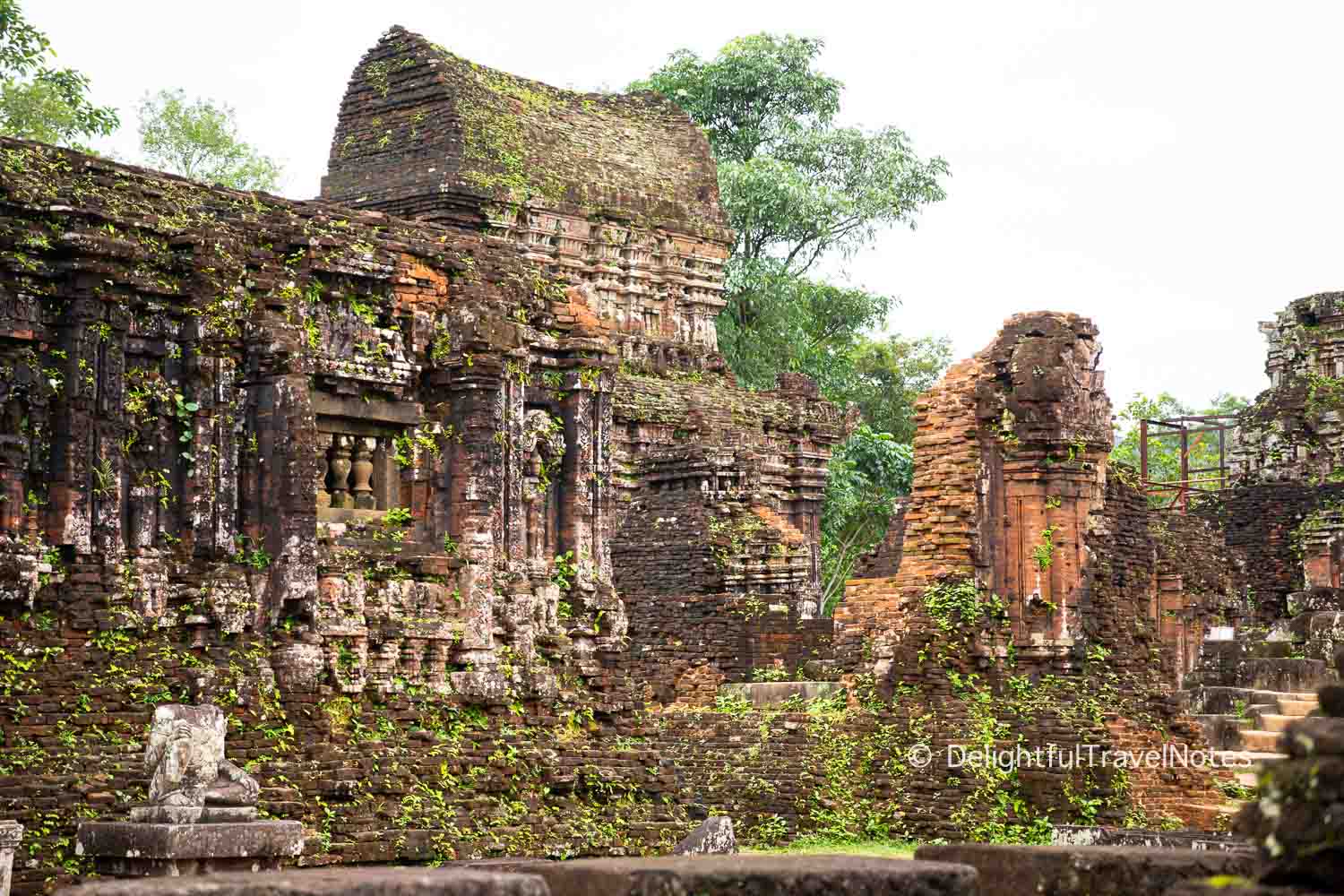
During our school years in Vietnam, our history classes barely touched on the Champa Kingdom and its civilization. So like the majority of Vietnamese people, growing up, we knew very little about the Cham people and their culture. It was only as adults, through the opportunities to travel and explore, that we began to learn about and appreciate their remarkable achievements in construction, architecture and art.
History of My Son Sanctuary
Mỹ Sơn Sanctuary (Thánh Địa Mỹ Sơn in Vietnamese) dates back to the 4th century when it was established by the kings of Champa as a religious center dedicated primarily to Hindu deities, especially Shiva. Researchers think it also served as a royal burial site.
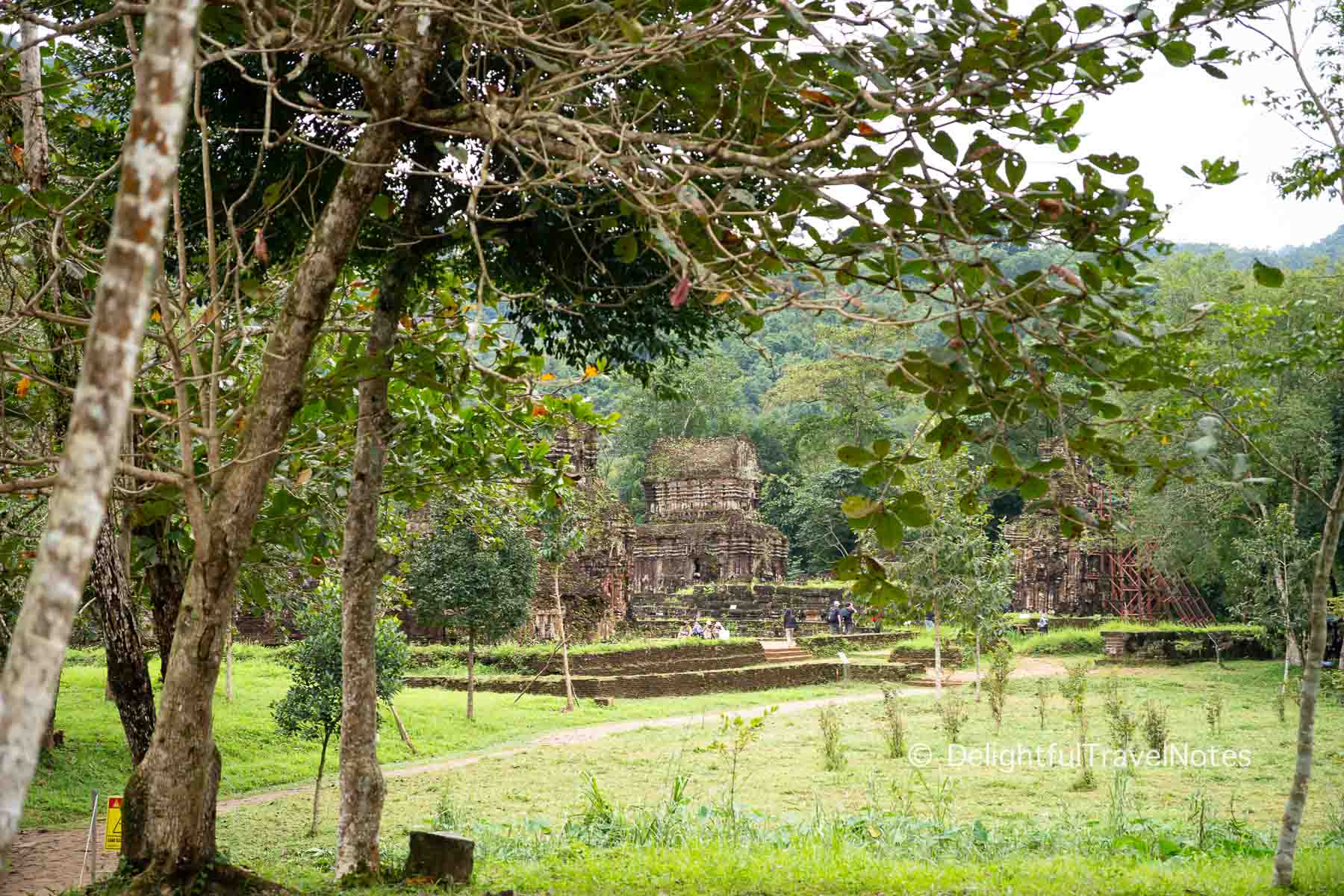
Champa or Cham (Chămpa, Chăm, or Chàm in Vietnamese) was a collection of independent Cham polities that extended across the coast from what is present-day Quang Binh in Central Vietnam to Phan Thiet in Southern Vietnam. This ancient kingdom is thought to emerge in the late 2nd century, and reach its peak in the 9th and 10th centuries. After that, it began a gradual decline and was annexed into Vietnam in the early 19th century.
The temples and towers at My Son were constructed and maintained from the 4th to the 14th century. With its unique red brick construction and sandstone bas-reliefs, the site showcases the outstanding engineering and artistic achievements of the Cham civilization.
Hinduism was spread to the Champa Kingdom in the early centuries AD by Indian traders. This religion was easily integrated with the indigenous beliefs of the local, therefore, the kingdom quickly adopted the practice of worshipping Shiva. As a result, My Son’s architecture is predominantly influenced by Hinduism, which is evident in the temple designs, motifs, and the depiction of Hindu deities.
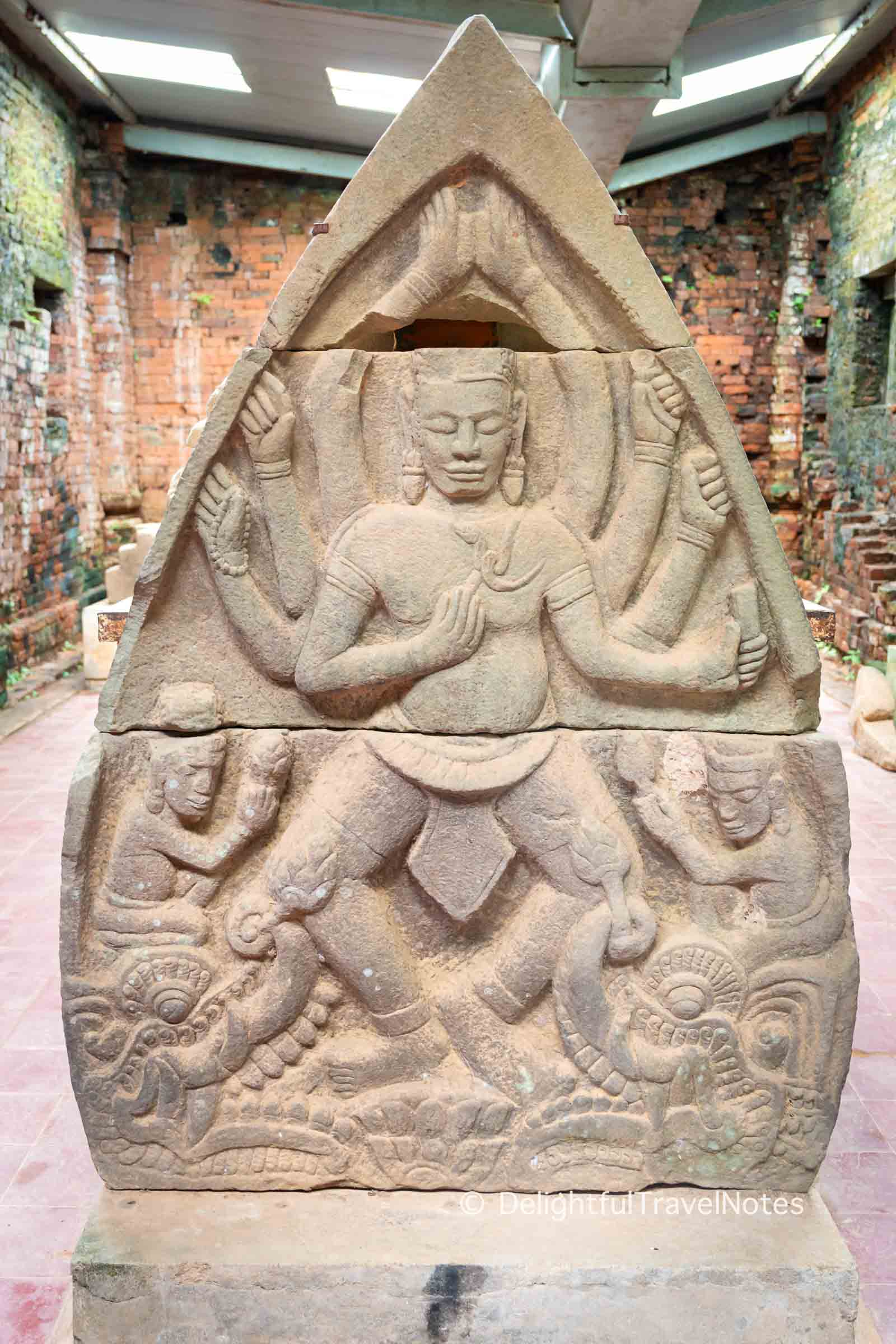
Following the decline of the Champa Kingdom, My Son was largely forgotten and reclaimed by the jungle until its rediscovery by French archaeologists in the late 19th and early 20th centuries. Research by French scholars showed that there were about 70 temples at My Son at that time. However, during the Vietnam War, My Son suffered significant damage due to bombing, and nowadays, there are remnants of only about 30 temples left. Restoration and preservation have been carried out with the help of experts from other countries.
Is My Son Sanctuary Worth Visiting?
Often compared to and overshadowed by Angkor Wat in Cambodia, My Son might initially appear more damaged, with fewer intact temples – leading some visitors to have a sense of disappointment from what I could see from TripAdvisor reviews. While the site may not be as expansive or as well-preserved, we think My Son Sanctuary is definitely worth visiting for several reasons:
- Historical context: as the religious center of the Champa Kingdom, the site provides unique insights into a significant but lesser-known civilization in Southeast Asian history.
- Art and architecture: severely damaged by time and war, none of the architectural structures at My Son remain intact. However, the relics that remain display outstanding and unique craftsmanship of Cham people. Focusing on the distinctive construction techniques and intricate carvings will make a trip to My Son more rewarding, rather than expecting grand structures.
- Natural setting: My Son’s location in a remote, forested valley allows visitors to take a leisurely walk and enjoy the natural beauty and tranquility of the surroundings.
Before Your Visit
There are informational boards and a museum onsite at My Son Sanctuary (with English translation). However, we think your trip will benefit greatly from one or more of the following things:
- Having a knowledgeable guide to give you a tour at the ruins and provide background information and history. There are guides onsite but they may not be available all the time. You can look for a guided tour on Viator.
- Having visited the Da Nang Museum of Cham Sculpture in Da Nang city center. The museum boasts an extensive collection of Cham sculptures, many of which were excavated at My Son Sanctuary. The museum also provides knowledge about the structure of a Champa temple complex, the artistic achievements and religious practices of the Cham civilization.
- Having visited other Cham temples in Vietnam, such as those in Quy Nhon and Binh Dinh. Some of these are still quite well-preserved and can help you imagine the grandeur of My Son before it was abandoned and damaged. Note, however, that the art and architectural styles changed over time, and many of My Son temples were constructed when the Cham civilization was at its prime.
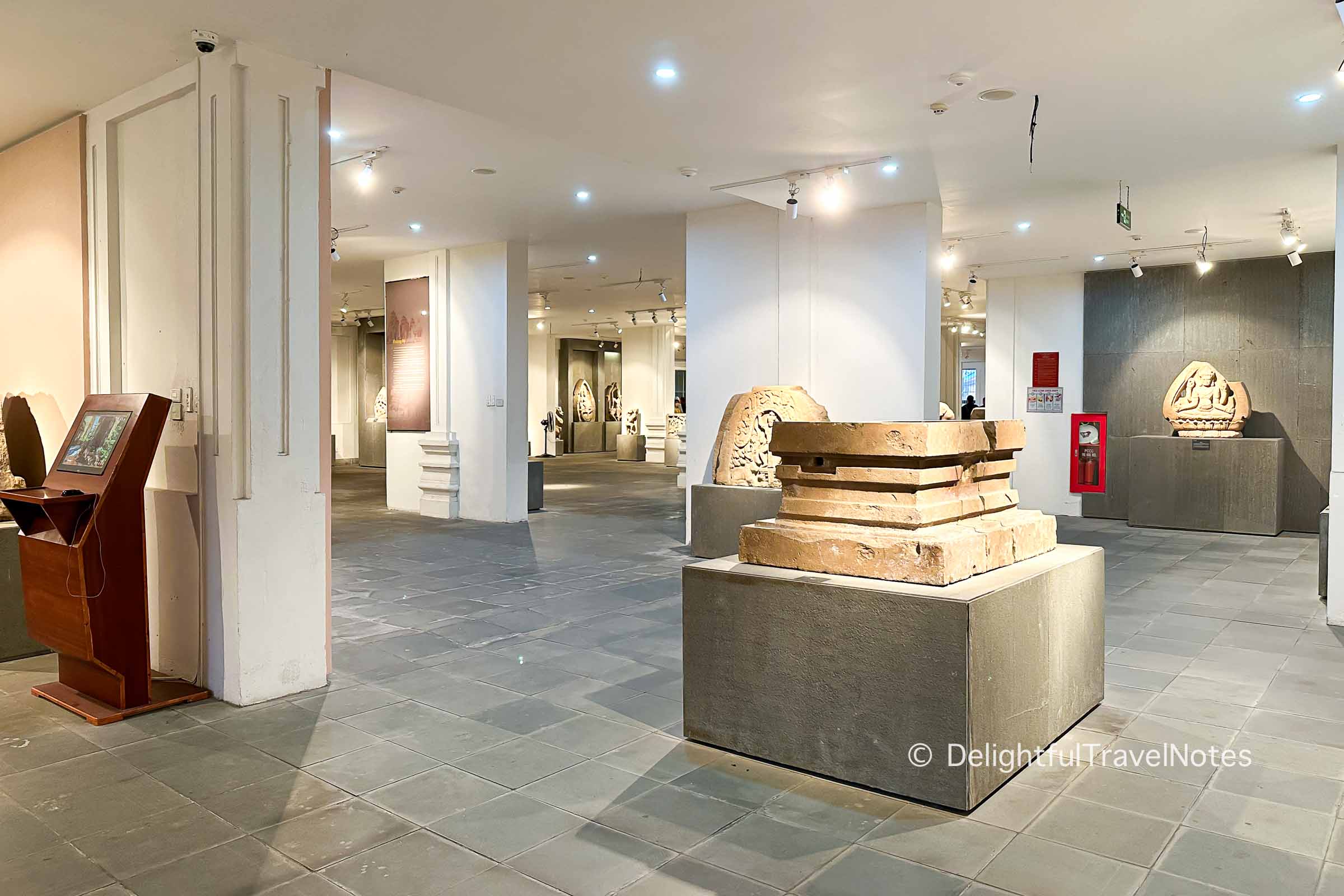
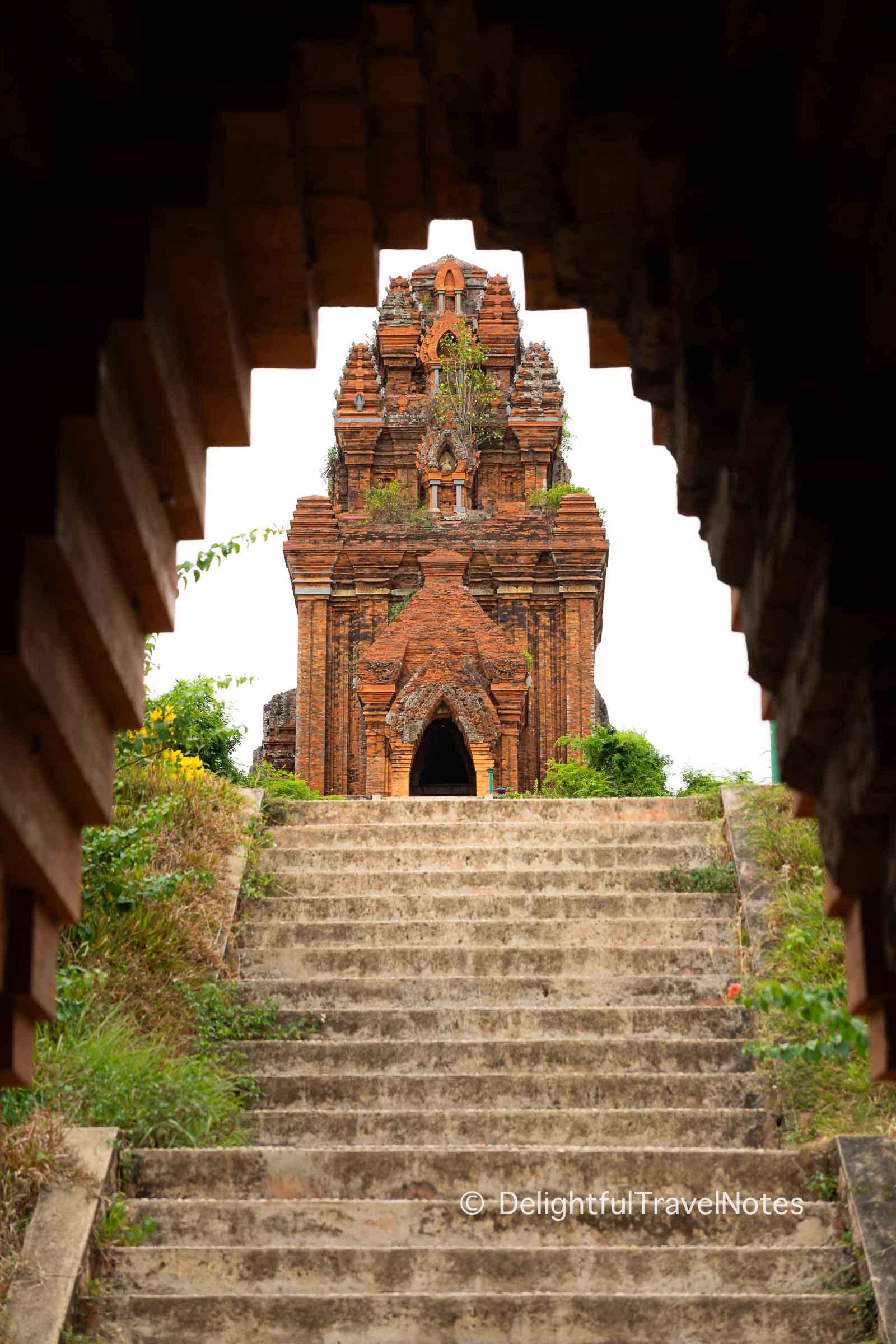
Transportation
My Son is located in a remote forested valley in Quang Nam Province, about an hour drive from Da Nang or Hoi An. Here are the two popular options to get here from Da Nang or Hoi An:
- Guided Tour: Many visitors choose to join a guided tour, which typically includes transportation to and from My Son, a tour guide, and sometimes additional stops or activities. Tours can be booked from Hoi An or Da Nang and vary in price and quality. You can choose a private tour or a group tour.
- Private Car or Taxi: You can easily hire a private car or take a taxi for a round trip from Hoi An or Da Nang to My Son. Taxi drivers are generally happy with waiting for visitors. This option offers more flexibility in terms of schedule and can be more comfortable, but it’s generally more expensive than the other option and it doesn’t come with a tour guide.
We hired a XanhSM taxi for a round trip from our accommodation at Tia Wellness Resort in Da Nang to My Son and paid about 1.5 million VND ($60). Our driver didn’t mind waiting for us at all, and we could spend as much time as we wanted at the ruins.
Visiting Hours
My Son Sanctuary is open from 6 am to 5 pm. We were told that the least busy times to visit were very early in the morning and around noon.
- If you can wake up early, consider having a sunrise/early morning tour to My Son. This is an especially good idea in the summer months, when the Central region of Vietnam experiences very hot and humid conditions.
- If you visit during winter time, the weather is pleasant even at noon. Our visit was on an overcast day in late December, which allowed us to take our time wandering through the ruins without the discomfort of intense heat or direct sunlight.
If you are interested in history and architecture, it is best to budget an ample amount of time at My Son, at least 3 hours. We spent a total of 4 hours, and still felt like we could have stayed a bit longer.
Entrance Fees
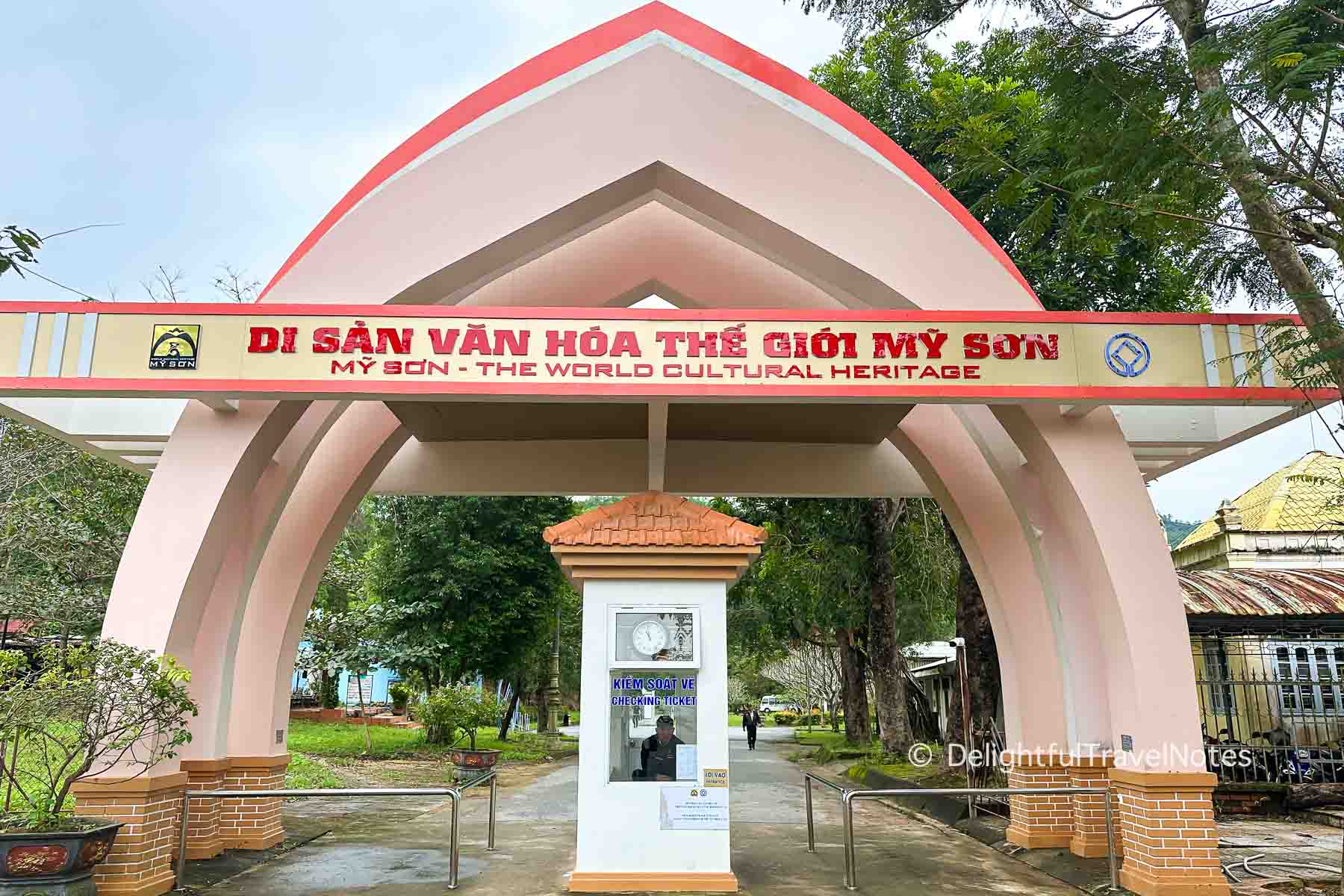
The current entrance fees in 2024 are 100,000 VND for Vietnamese visitors and 150,000 VND for foreigners. The ticket includes access to both My Son Sanctuary and My Son Museum, as well as the use of electric shuttles for transportation from the entrance to the ruins and the opportunity to enjoy the Apsara dance.
Additionally, visitors have the option to pay an extra 70,000 VND for an audio guide. This guide is accessible via an app that you can download to your phone, allowing you to listen to corresponding audios as you explore the ruins. I expected the audio guides to be a bit more detailed and comprehensive, however, I think it is a cheap and decent alternative to a guided tour. It’s best to bring your bluetooth earphones, such as Apple earbuds, if you plan to use their audio guide app.
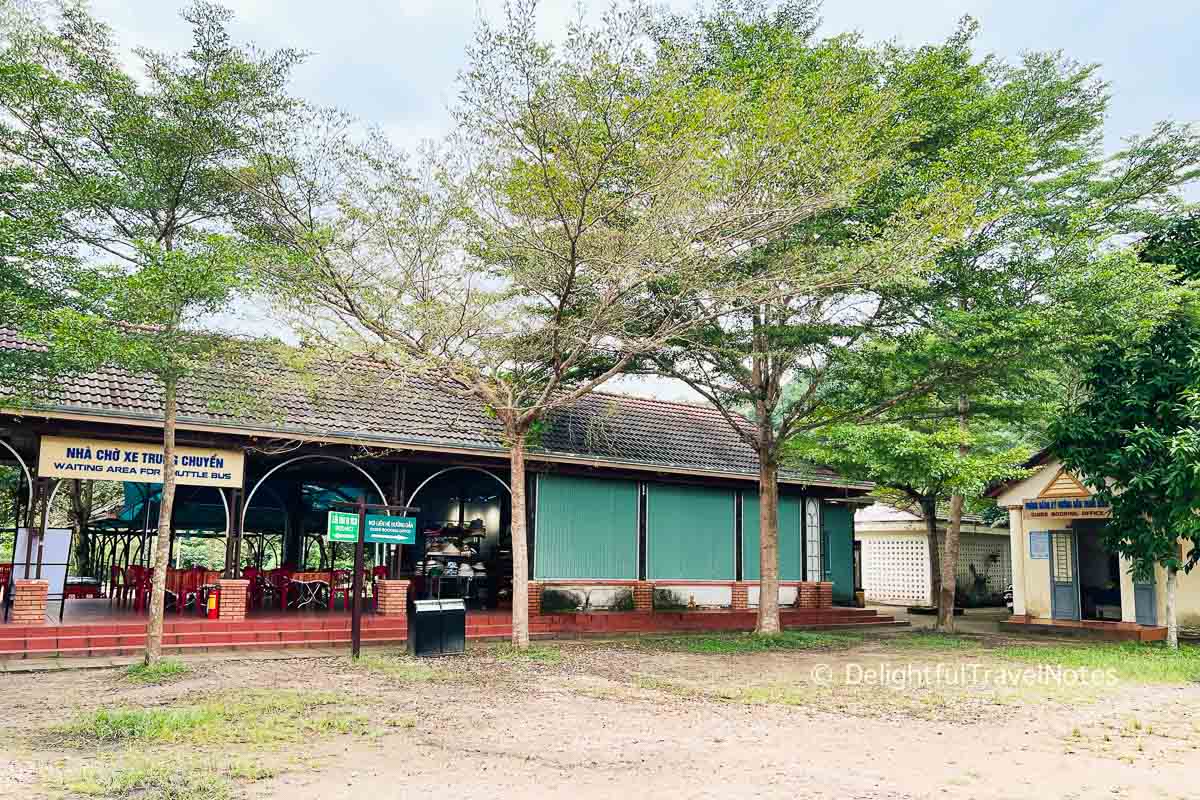
There is a team of official guides at My Son Sanctuary who can provide tours in several foreign languages besides Vietnamese, such as English and Japanese. You will find the office of the guides right next to where the electric shuttles drop you off. The cost of the tour is very cheap and we enjoyed the insightful information and stories our guide told us. However, there are a couple of things you should know:
- The team has only 6 or 7 guides, so if you go at a peak time, none of the guides may be available to accompany you.
- The guided tour consists of an overview of the sanctuary, its history, and detailed information of the temples in groups B, C, D. You will need to explore other groups of temples yourselves. To be fair, groups B, C, D are the most well-preserved at My Son.
Arrival and Overview
After purchasing your tickets, enter the gate to the sanctuary and make your first stop at the My Son Museum. This museum offers an enriching introduction to the site, displaying maps, diagrams, artifacts, and detailed analyses. These exhibits provide insights into the art style and construction techniques of My Son temples. Depending on your interest, you can spend anywhere from 30 to 60 minutes in the museum.
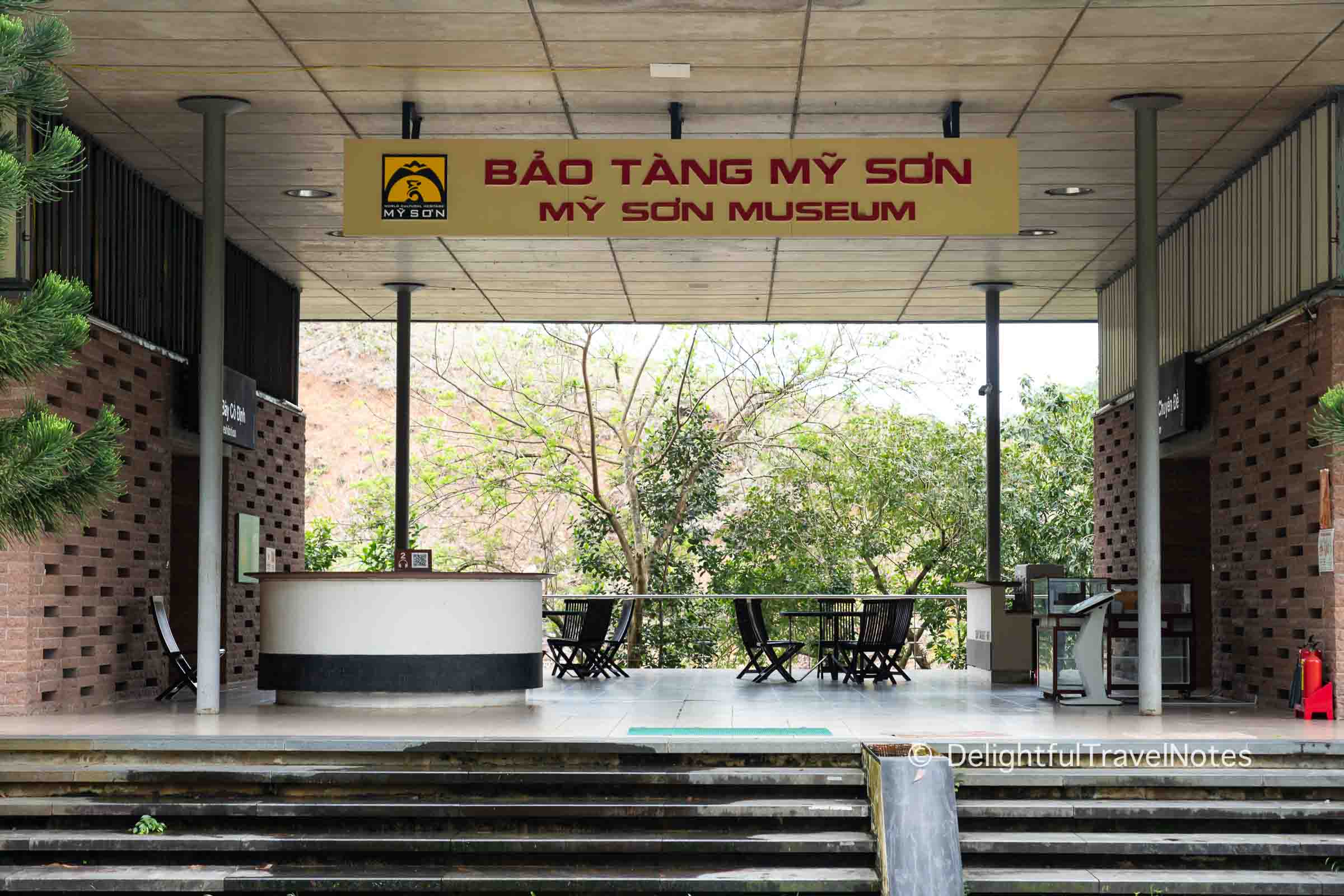
Upon exiting the museum, you have the option to either walk or take an electric shuttle to reach the ruins. The drop-off point for the shuttle is also the location of the guided tour office (as mentioned above). From here, you can start walking and exploring clusters of My Son temples which scatter through out the valley.
Henri Parmentier, the French scholar who conducted extensive studies of My Son in the early 20th century, classified the temples into 14 groups based on their locations, including 10 principal groups each consisting of multiple temples. Each principal group was assigned a letter: A, A’, B, C, D, E, F, G, H, K. Within each group, each temple was assigned a number. Among these groups, groups B, C and D are the ones that are in a better state than the rest.
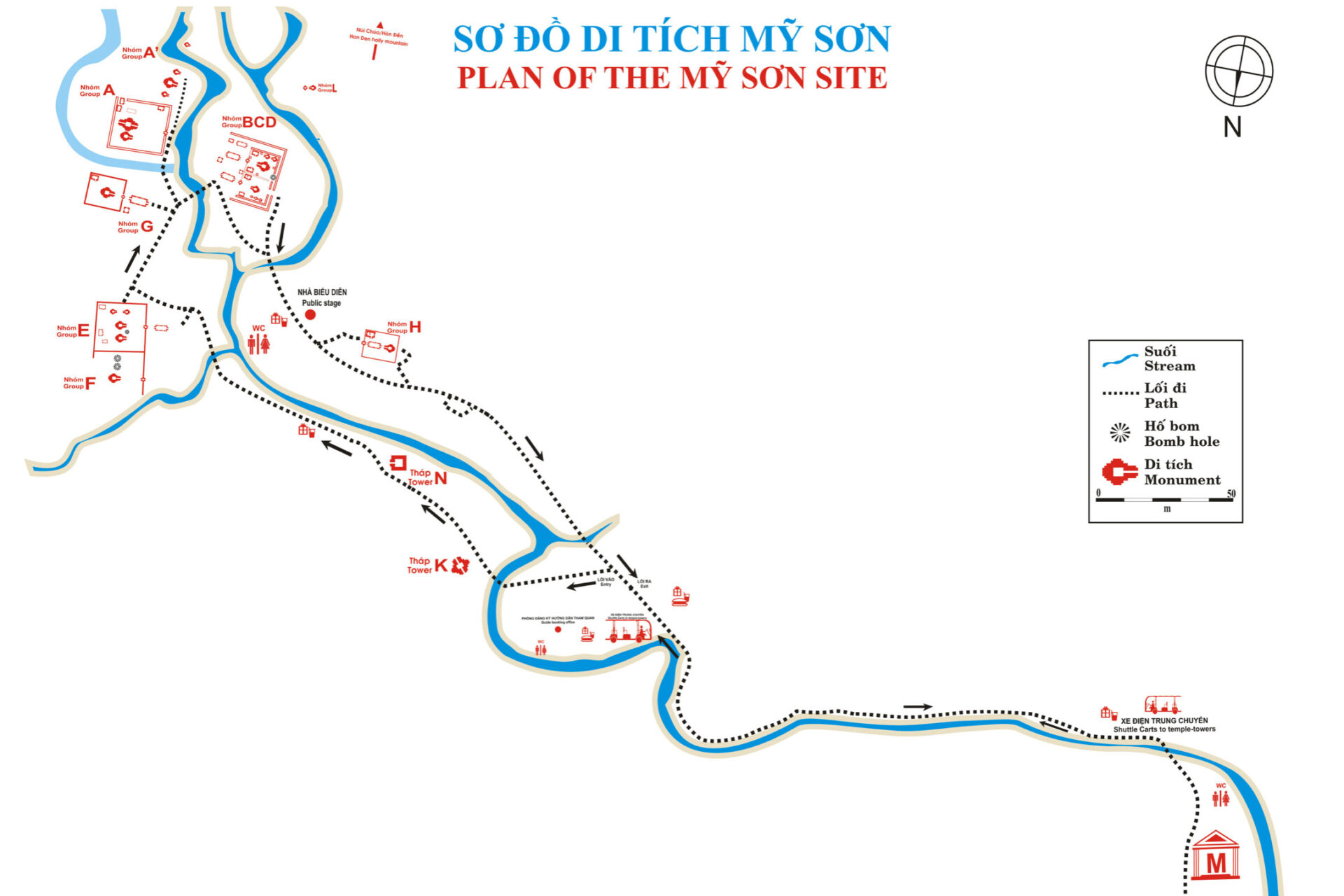
The official map of My Son shows the following route: Group K – Groups E, F – Group G – Group A – Groups B, C, D – Group H – Exit. We took a reverse route which seemed more logical to us as we got to see the largest and most well-preserved groups first.
If you want to watch the Apsara dance, take note of the start time to plan your route accordingly. We had already seen an Apsara dance at the Nguyen Hien Dinh Classical Drama Theater the night before, so we skipped this.
Whichever route you choose, it’s important to stay on the designated path, as there may still be undiscovered bomb fragments in the area. You will need to walk quite a bit, about 5,000-6,000 steps or more in total.
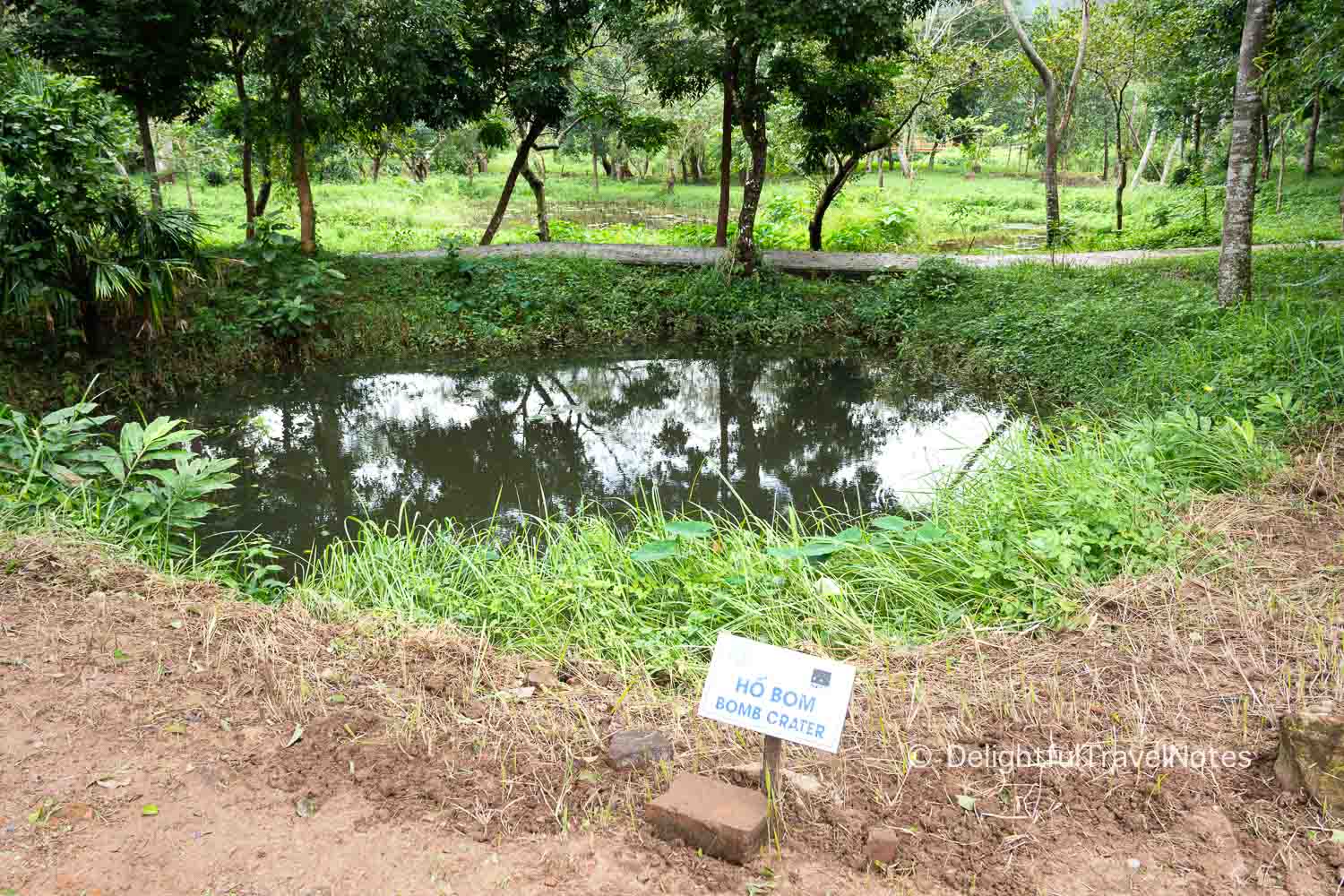
Layout and Structure
If you have visited Danang Museum of Cham Sculpture, you may already know the main structures of a Champa temple complex at My Son Sanctuary. Here are those structures with some examples:
- Main temple (kalan): such as B1 and C1
- Gate tower (gopura): such as B2 and C2
- Pilgrims house or front hall (mandapa): such as D1 (mandapa of B1) and D2 (mandapa of C1)
- South tower (kosagrha): such as B5
- Enclosure wall
- Stele
- Some small temples worshipping other deities

As you can see from the map, the kalan, gopura, and mandapa (B1-B2-D1 and C1-C2-D2) are aligned on an axis.
1️⃣ Main Temple (Kalan – Ngôi Đền Chính)
The main temple, or kalan, is the most important structure within the temple complex. It has a square foundation and consists of three parts, according to Hindu architectural concepts:
- The base symbolizes the mundane world
- The body of the tower represents the spiritual world
- The roof of the tower symbolizes the divine world
The inner sanctum of the kalan, the most sacred space of the temple, is a narrow room with a statue of the deities (usually Shiva) or a linga at the center. Linga is the abstract representation of the Hindu god Shiva. The statue or linga is placed on a yoni (an abstract representation of female organ) pedestal with a spout always facing north, which is used to drain holy water during the ceremonial bathing of the linga. Together, linga-yoni symbolizes the divine process of creation and regeneration.
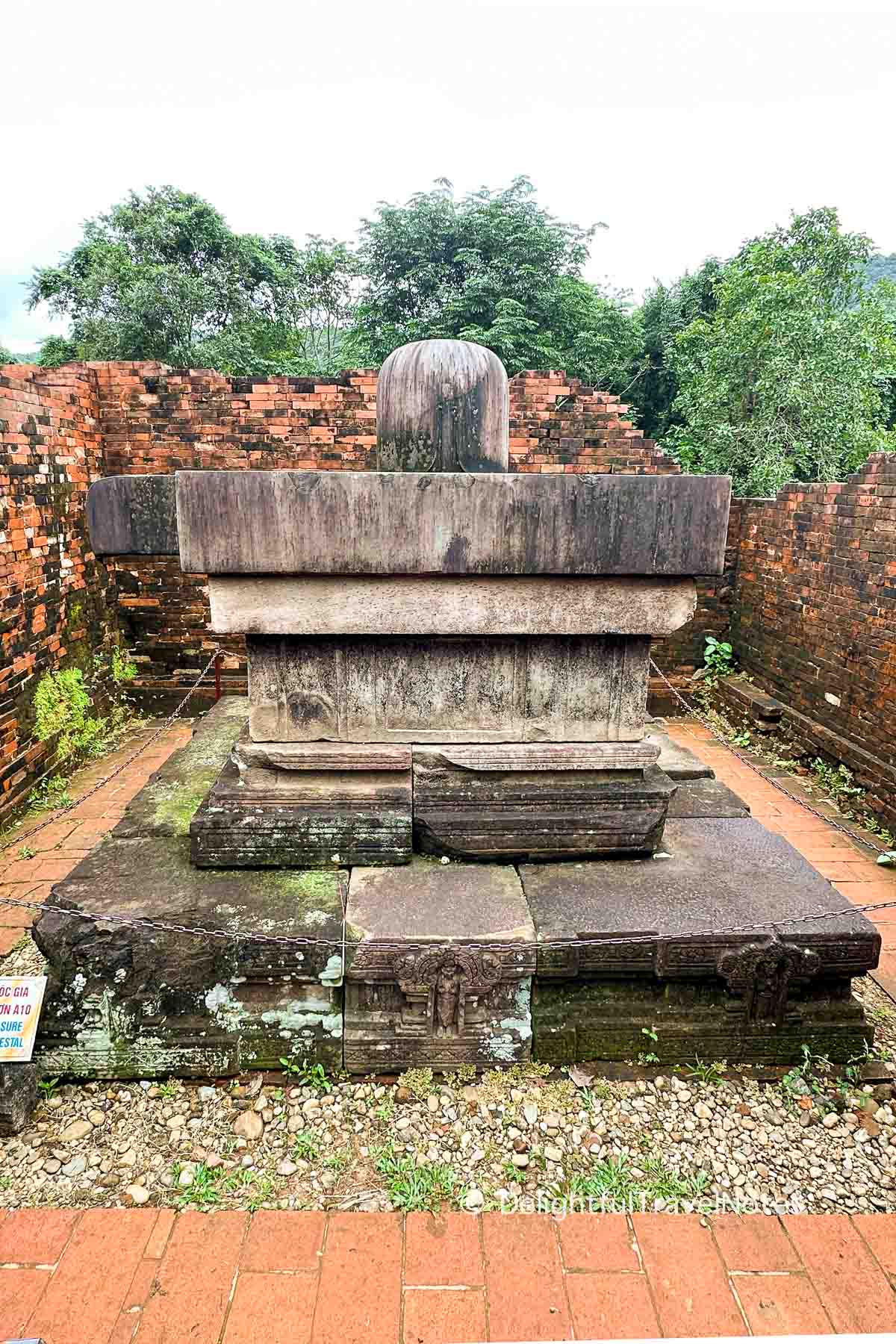
2️⃣ Other Structures
Opposite the kalan is a gate tower (gopura – tháp cổng) with two doors facing east-west. Gopura also has a square plan, but it is empty inside.
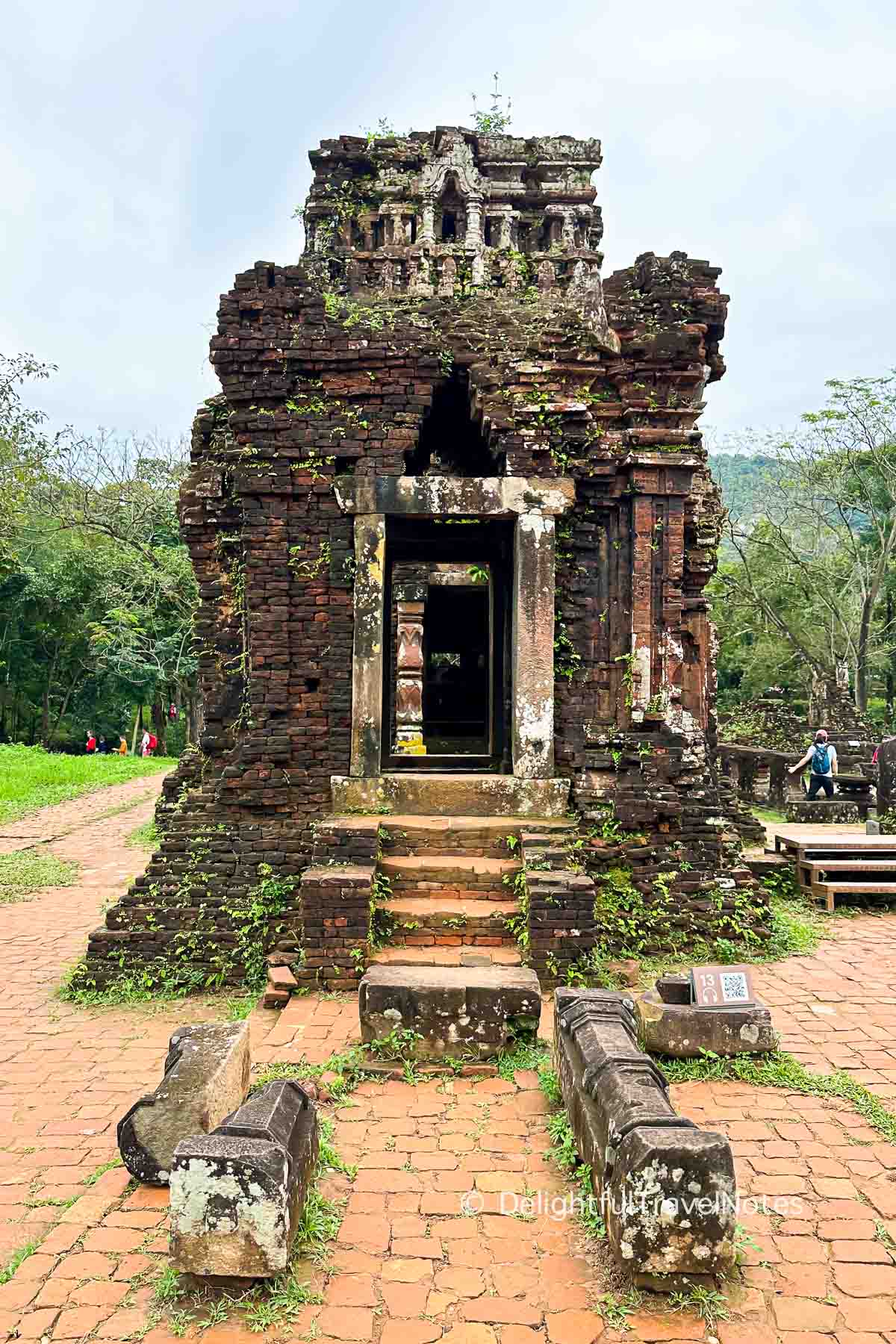
In front of gopura is a front hall (mandapa – tiền đường), a type of long house with a tiled roof, many windows, and two main doors opening east-west. This space is used for meditation, praying, chanting, and preparing offerings before entering the kalan for holy purification ceremonies. Nowadays, mandapa D1 and D2 are used to display some sculptures excavated at My Son Sanctuary.

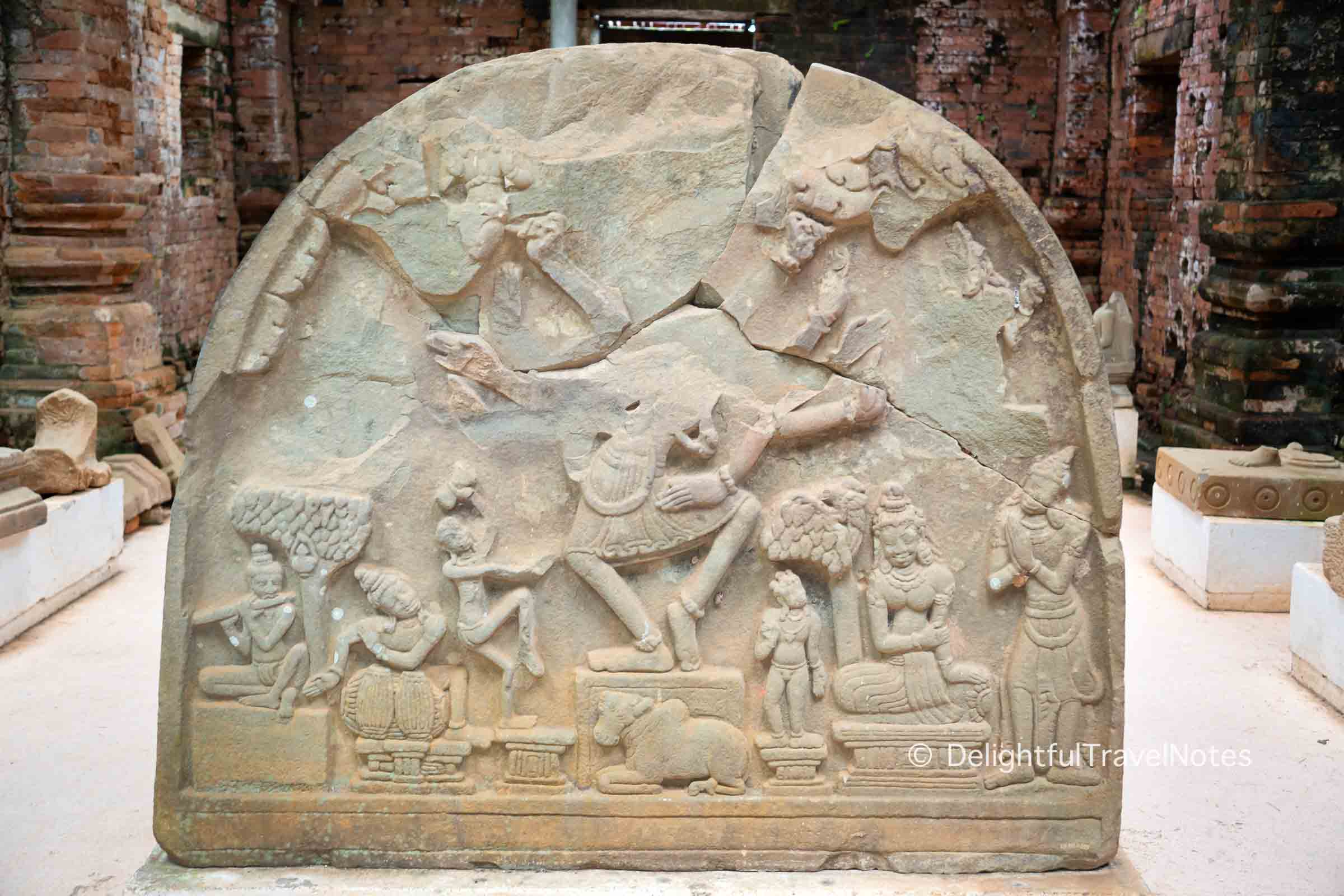
Within the enclosure wall of the complex, there is always a kosagrha tower. This is a brick structure with a curved, boat-shaped roof, and the main door always faces north – the direction of the Wealth God Kuvera. This tower was also used for cooking food offerings for the deities, and today, the Cham people in Ninh Thuận and Bình Thuận refer to these towers as fire towers (tháp lửa). The fire tower symbolizes the treasures and prosperity of the kingdom.
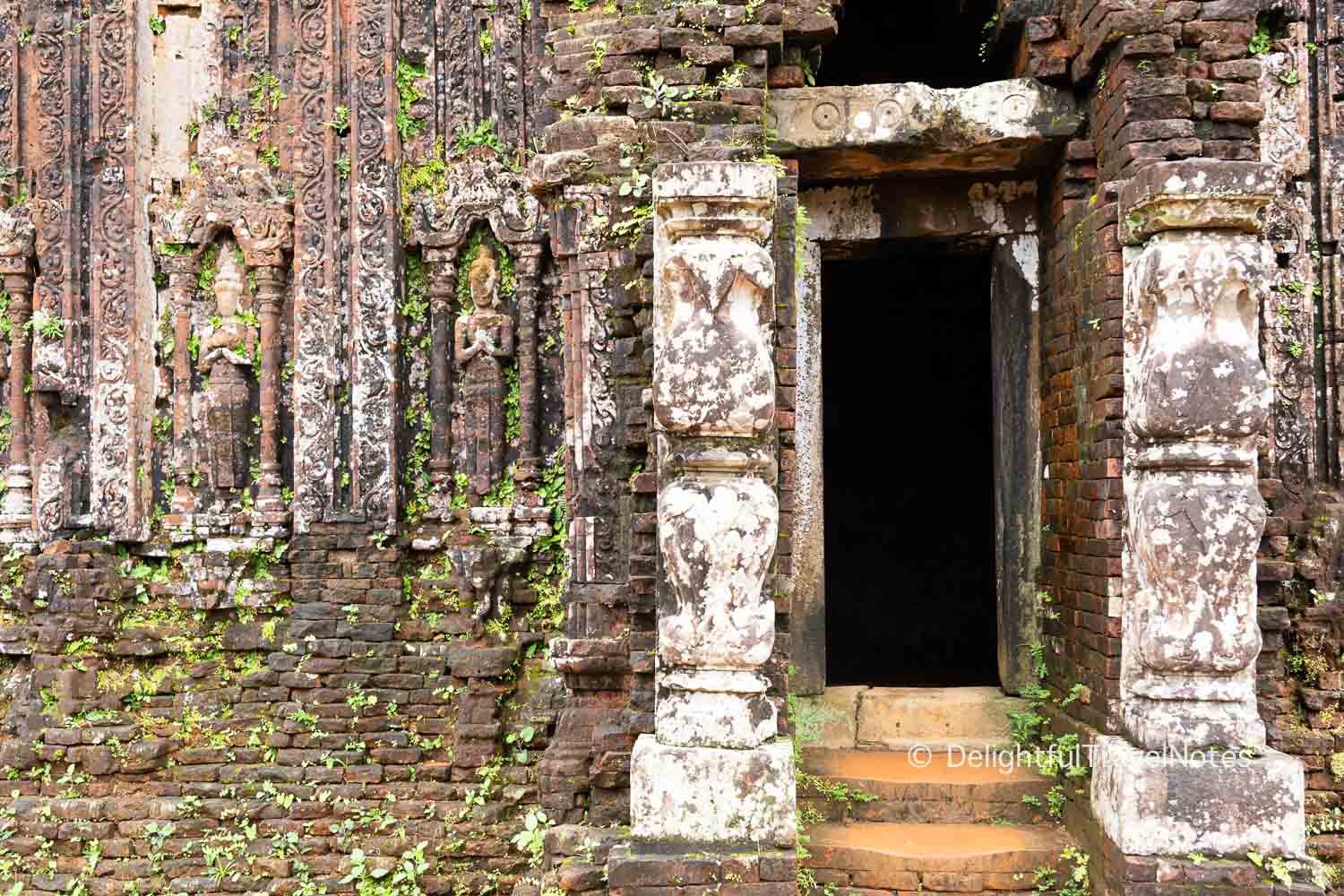
Materials and Construction Techniques
Unlike some other famous ancient structures made from stone, such as Angkor Wat and Bayon in Cambodia or Borobudur in Indonesia, Champa temples were built from bricks. The ancient Cham peple used corbel technique, in which bricks were stacked layer by layer, forming staggered ledges that protruded horizontally, creating a space between two walls, which was then gradually narrowed until it could be closed with a final row of bricks at the highest point.

The early temples were not tall due to less developed construction techniques. However, from the 9th or 10th centuries onwards, the techniques of the Cham people significantly advanced, enabling them to build much taller structures.
One of the most fascinating features of Cham temples is the special kind of brick and the unique method to bond them without any visible mortar. Compared to a modern brick of the same size, the ancient brick is about 25%-30% lighter. Researchers think Cham people used soft fired bricks, assembled together by hand rubbing. The most popular and credible theories suggest that they used a type of resin from a native tree, known as “dầu rái”, to bond the bricks together. As a result, the mortar joints between the bricks are very thin, often invisible to the naked eye.
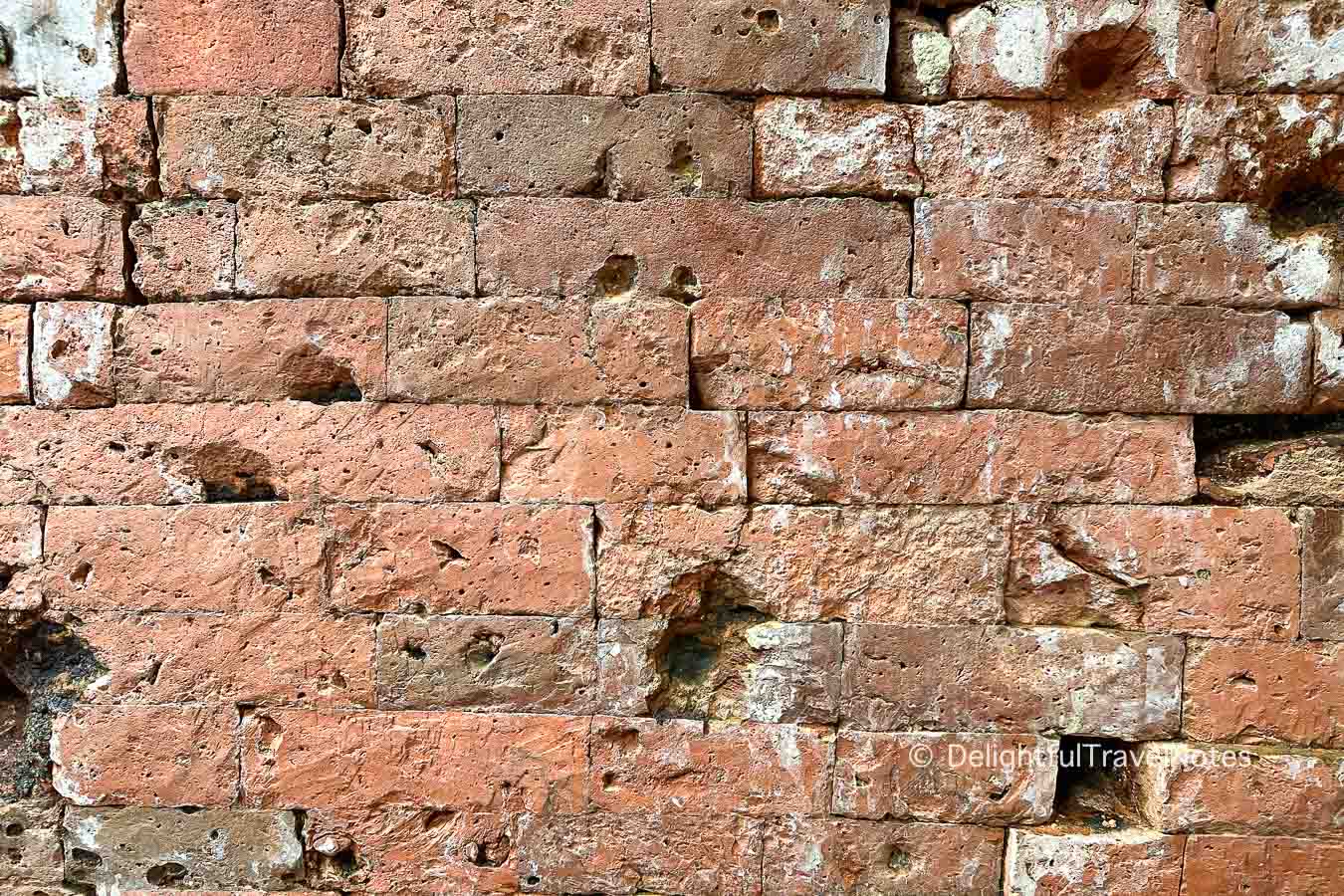
The original bricks and construction methods have stood the test of time much better than the materials and techniques used for restoration and preservation. They still retain their reddish color and are highly resistant to water damage and other weather elements. You can quite easily distinguish between the original bricks and those used in restoration at My Son. Modern bricks used in restoration often become blackened, develop moss and mold growth, or get discolored due to salt crystallization.
Architectural and Artistic Styles
My Son temples are not all of the same style and do not all belong to the same period of Champa history. This is also one of the things that make the ruins interesting, in our opinion.
Art historians and researchers have come up with several ways to classify Champa architectural and artistic styles. The most well-known and widely-accepted one was developed by Philippe Stern. He categorized the architectural and artistic legacy of Champa into seven styles or phases of development, six of which can be found at My Son. Notably, two styles originated from My Son, specifically the My Son E1 style (or ancient style) and the My Son A1 style.
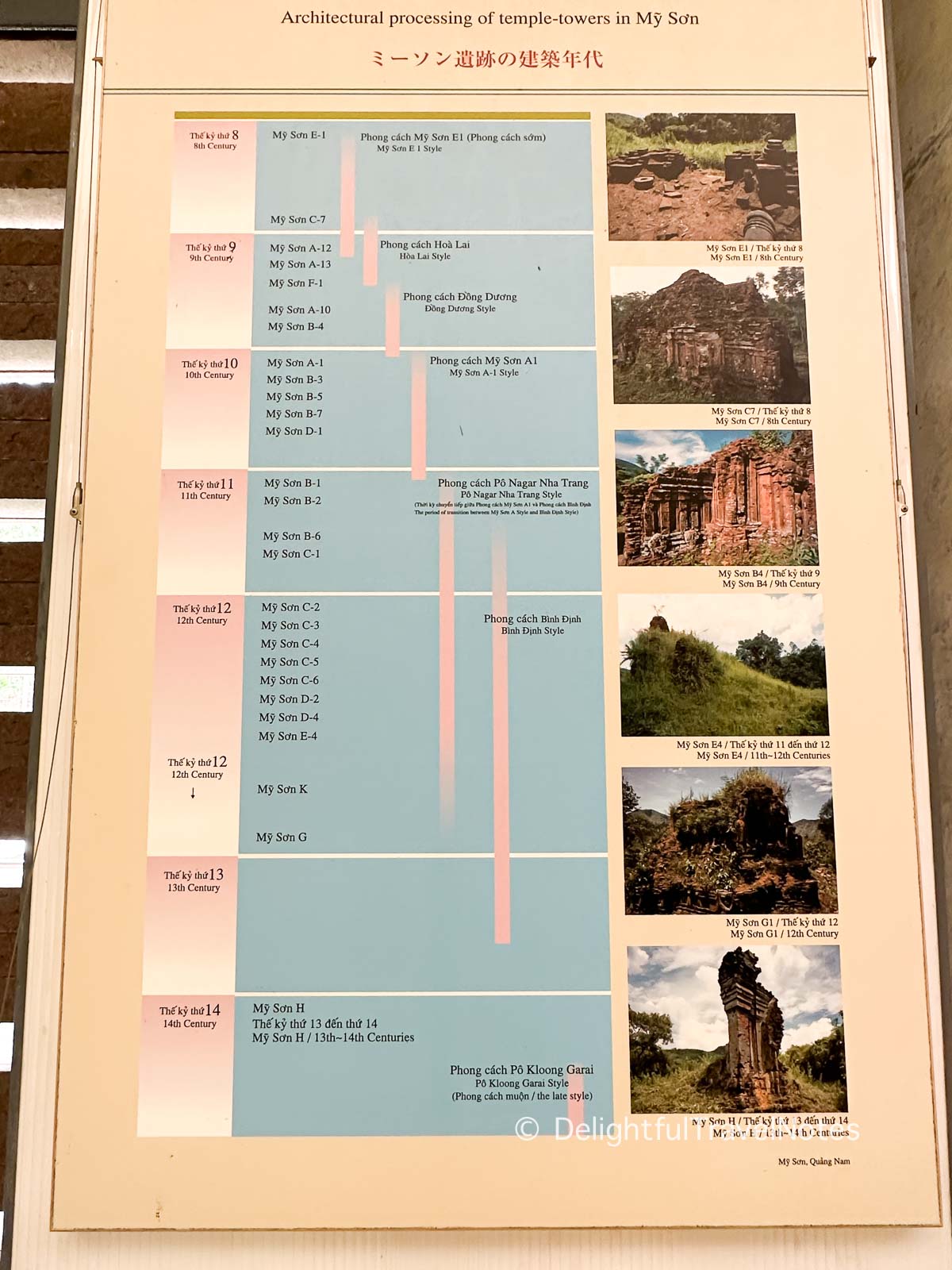
After the temple walls were built, sculptors began to carve patterns directly onto the bricks. They also installed sandstone bas-reliefs and statues. In my search for descriptive explanations of the classification of Champa art styles, I have learned that the classification is based on several elements, such as decorative motifs, features of the pillars/columns, friezes, cornices, pilasters, interpilasters, and lintels.
The earliest style, known as the My Son E1 style, was represented by temple E1, which had been completely destroyed during the war. Fortunately, parts of the sandstone pedestal of this temple were excavated, put back together, and are currently displayed at Museum of Cham Sculpture in Da Nang.
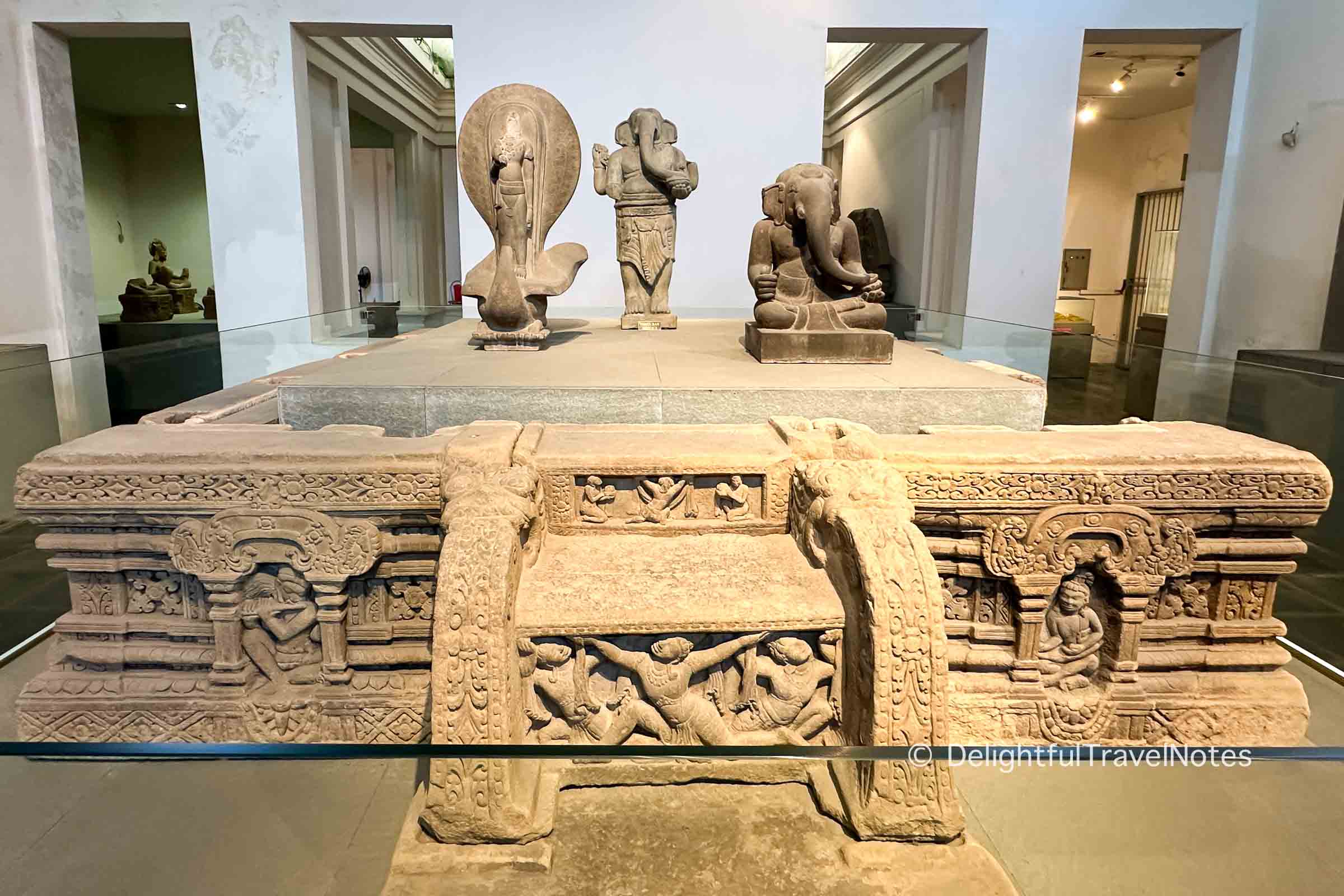
The majority of remaining structures at My Son ruins are in the A1 style, which is considered the pinnacle of Champa art. Temple A1 was destroyed, and the best representation of this style is currently temple B5. You can find sketches of temple A1 drawn by Henri Parmentier in 1904 within this article. The style is celebrated for its light, graceful, and elegant carvings, such as the floral motifs on the pilasters in the photo below.
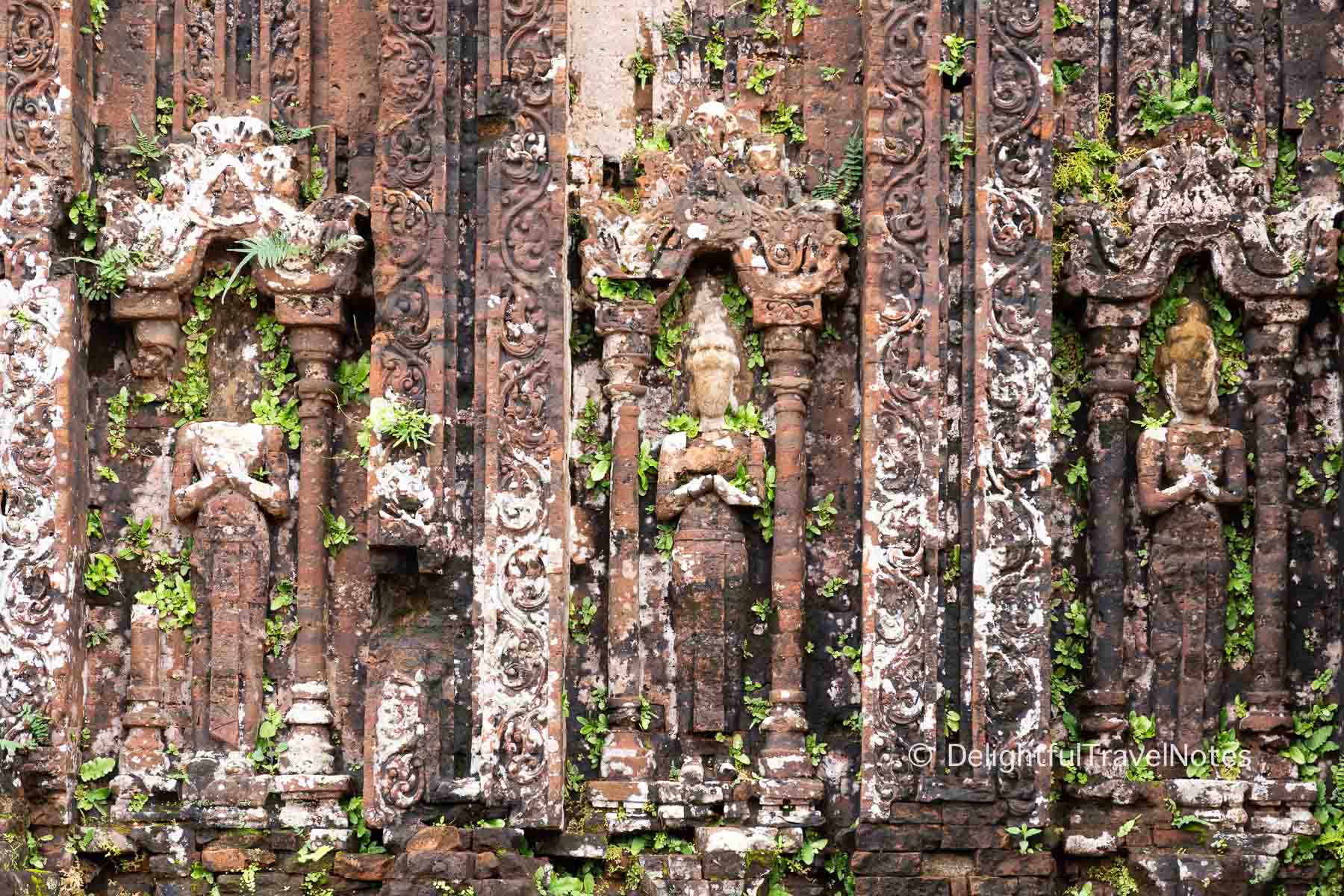
The later styles after the A1 style shifted the aesthetic from details to blocks and scale. For example, in the Binh Dinh style, the arches of the doors narrow and rise into spearhead shapes, the pilasters become flatter with no decorative motifs.
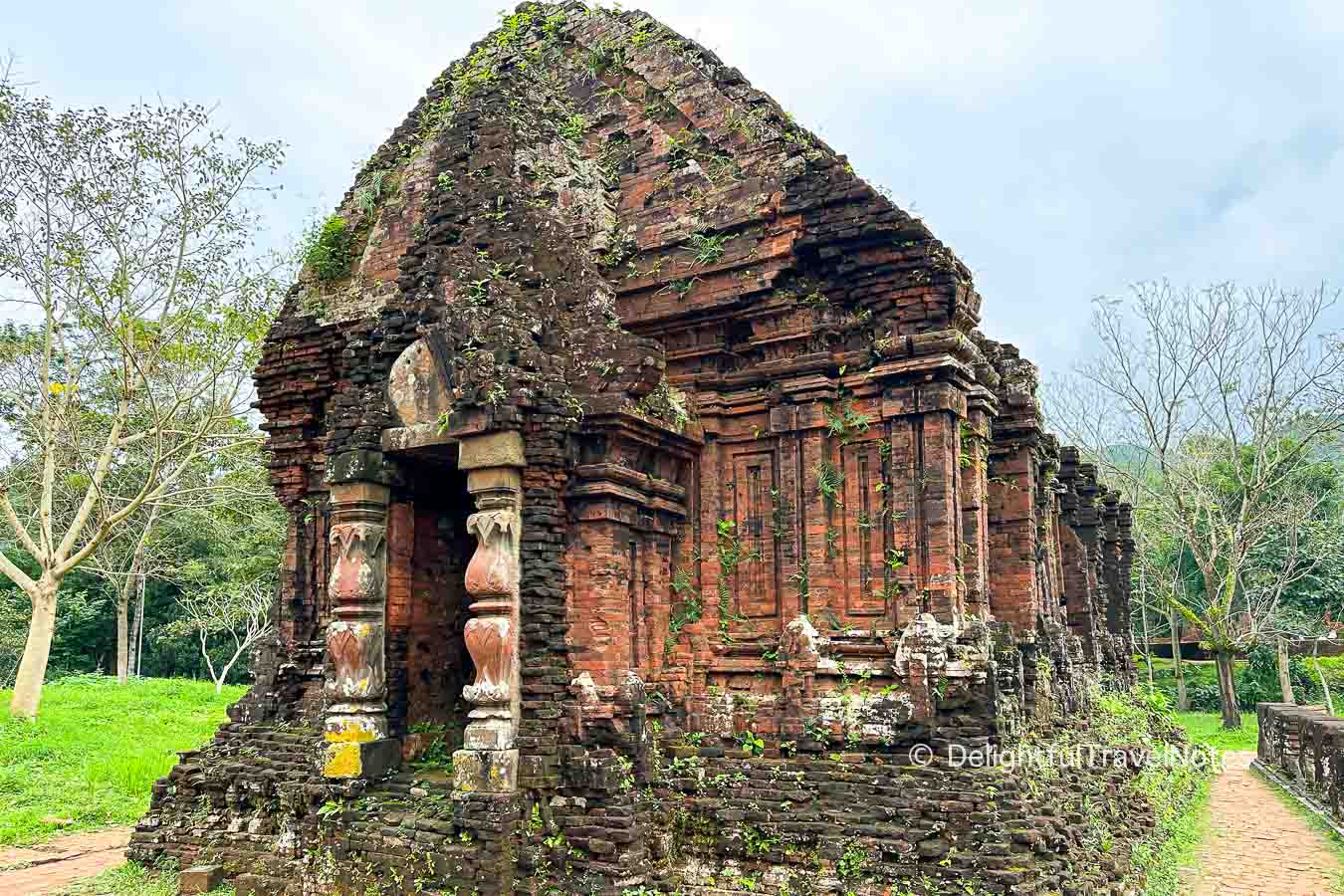
For ordinary visitors like us, distinguishing between these artistic styles may not be straightforward or obvious. Therefore, I recommend checking out my post about My Son temples, in which I discuss the main groups of temples at My Son Sanctuary in more details and highlight the architectural and artistic features I’ve learned about so far.
After Your Visit
After visiting My Son Sanctuary, you can head back to take a rest and have a meal at these excellent restaurants in Da Nang. If we had had more time, we would have definitely loved to revisit the Da Nang Museum of Cham Sculpture to connect the dots between what we observed at My Son ruins and what are displayed and explained at the museum.
Once we came back home, we did a lot more reading about the history and architectural styles of the temples. Now having a little more knowledge, we are eager to return to My Son as well as the Museum of Cham Sculpture again to acquire further observation and understanding. A second visit, we believe, will enrich our understanding and provide a deeper appreciation of the details that we might have missed during our initial exploration.
If you found this article helpful, please consider saving it to Pinterest!

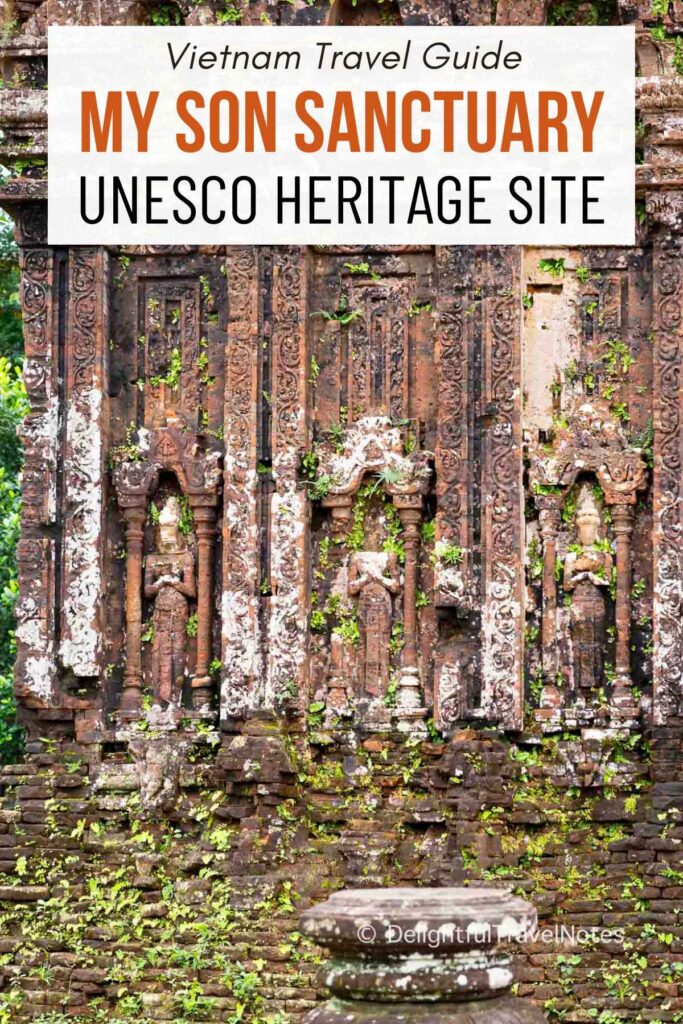

Explore More
Best Places to Stay in Hanoi: Not the Old Quarter
Top Must-Try Restaurants in Hanoi – A Local’s Guide
Top 12 Best Vietnamese Restaurants in Ho Chi Minh City – A Local’s Guide
One Comment